-Tate-(Lucy-Green)-(2).jpg)
Now You See Us. Women Artists in Britain 1520-1920, installation view, Tate Britain 2024. Photo © Tate (Lucy Green).
Tate Britain, London
16 May – 13 October 2024
by ANNA McNAY
A young woman, dressed in black with a bonnet and long shawl, accompanied by a small boy, stands waiting, eyes down, fidgeting nervously with a piece of string, while a portly older man looks haughtily at a painting she has brought into his shop. Behind her, two men in top hats peer superciliously at her over the top of a picture of a ballet dancer. This well-known painting, Nameless and Friendless (1857) by Emily Mary Osborn, was, according to the feminist art historians Ann Sutherland Harris and Linda Nochlin, “meant to be ‘read’ rather than merely looked at, to arouse moral feeling rather than simple appreciation of its visual qualities”.1 The plight of women was one of Osborn’s principal themes, and sentimental genre scenes, emphasising the blameless domestic lives led by middle-class women – the so-called “Angel in the House” – were popular with the Victorians, but to show a professional female artist in distress like this was unusual to say the least.2 The painting has, perhaps unsurprisingly, been misinterpreted by (male) critics as, for example, “a gentlewoman reduced to depending upon her brother’s art”,3 and, indeed, Osborn’s own career was far removed from that of her protagonist, since, the daughter of a priest, she was encouraged to be an artist by her family and was supported by wealthy patrons, including Queen Victoria. Osborn used this position of power, however, to help improve the lives of those like her protagonist here and in other works. She was also a member of the Society of Female Artists, established two years before she made this work to help women overcome the difficulties they faced in exhibiting and selling their work. This painting, and this artist, offer a good introduction to questions on the lot and subsequent battles of female artists throughout art history – if, indeed, this disconsonant concept of the “woman artist” even exists.
When Nochlin published her seminal essay, Why Have There Been No Great Women Artists?,4 in 1971, discussion of this issue came under the spotlight. However, as a further two feminist scholars, Rozsika Parker and Griselda Pollock, pointed out a decade later, the very title of this essay is problematic, since it implies a negative, stating, in the guise of a question, that there have been no great women artists – which is absolutely untrue.5 “To discover the history of women and art is in part to account for the way art history is written,” they continue. “To expose its underlying values, its assumptions, its silences and its prejudices is also to understand that the way women artists are recorded and described is crucial to the definition of art and the artist in our society.”6 If we look back to the first century AD, the Roman scholar Pliny the Elder cites six female artists of antiquity in his Historia Naturalis (AD77-79), some of whom reappear in Boccaccio’s Concerning Famous Women (1413). In the mid-16th century, the first edition of Giorgio Vasari’s Lives of the Most Eminent Painters, Sculptors and Architects included Pliny’s six women and added a sculptor, Properzia de’Rossi. In the second revised and enlarged edition of 1568, Vasari discussed the work of 13 female artists. By the 18th century, upper- and middle-class women were contributing to European culture in many ways, including by hosting salons, writing books and studying history, the arts and sciences. Published documents reveal that almost 300 women were working as professional artists at this time.7 Nevertheless, as the Scottish artist Katherine Read wrote to her brother in early 1752: “I cannot help looking on myself as a creature in a very odd situation; ‘tis true we are all strangers and pilgrims in this world, and I ought not to think myself more so than others, but my unlucky sex lays me under inconveniences which cause these reflections.”8 A century later, in 1876, Ellen Creathorne Clayton published her two-volume work, English Female Artists, noting that the Royal Academy had “studiously ignored the existence of women artists, leaving them to work in the cold shade of utter neglect” and, beyond that, they were “viewed with half contemptuous indulgence”.9
.jpg)
Martha Darley Mutrie, Wild Flowers at the Corner of a Cornfield, 1855-60. Photo: Tate (Seraphina Neville).
In 1976, Sutherland Harris and Nochlin curated a hugely significant exhibition at the Los Angeles County Museum of Art (LACMA), entitled Women Artists: 1550-1950. It exploded still further the study of female artists (missing) from the historical canon, leading to many being either “rediscovered” or “reinstated”. In the preface to the catalogue, however, they admit that it had “proved extraordinarily difficult to assemble the group of works”, and that in “a few cases the remarks of museum directors revealed, we believe, a lack of support for the concept of the exhibition itself and hence an unwillingness to lend major works to the show”.10 Now, nearly half a century later, Tate Britain is hosting a similar exhibition, covering roughly the same time frame, if somewhat more restricted in geographical scope: Now You See Us. Women Artists in Britain 1520-1920. You might be forgiven for asking what took Tate so long. That said, this exhibition is riding on the wave of recent – and concurrent – solo spotlights, such as Artemisia Gentileschi at the National Gallery in 2020, Angelica Kauffman at the Royal Academy earlier this year, and Mary Beale now at Philip Mould & Co, to name but a few examples. Polly Staple, director of collection, British art, at Tate says: “Tate’s collection is at the heart of everything we do. So, it’s vital that our collection reflects art history in all its diversity, including these groundbreaking and inspirational women artists.” Out of 200 works (by more than 100 artists) in this exhibition, however, only 16 come from Tate’s own collection, four of which – Mary Beale’s Anne Sotheby (1676-77); Rebecca Solomon’s A Young Teacher (1861) (a joint acquisition with the Museum of the Home); Martha Darley Mutrie’s Wild Flowers at the Corner of a Cornfield (c1855-60) (acquired in 2022); and Louise Jopling’s Through the Looking-Glass (1875) – are being feted as recent acquisitions.
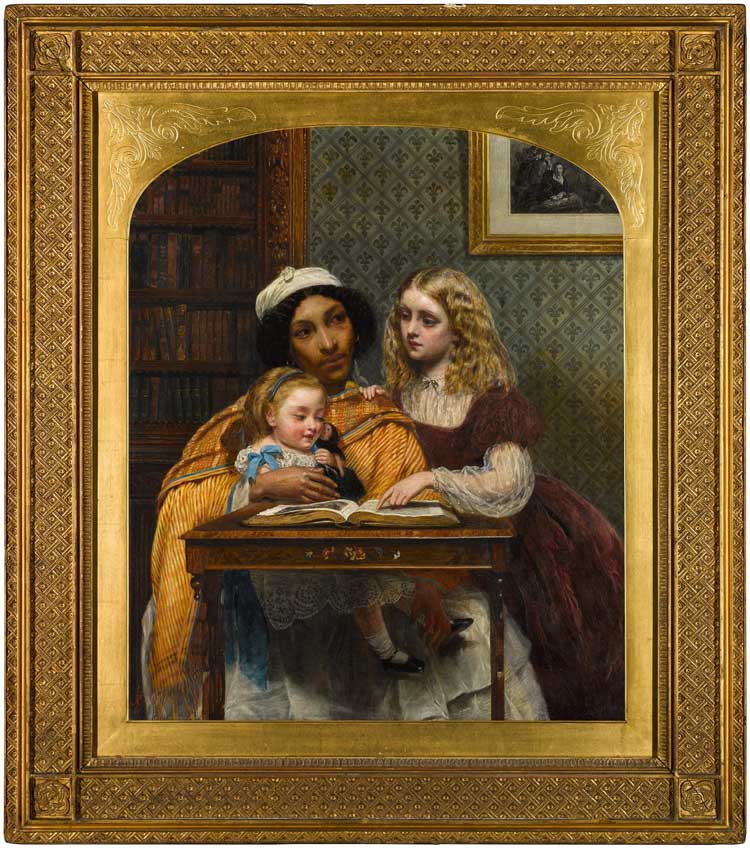
Rebecca Solomon, A Young Teacher, 1861. Tate and the Museum of the Home.
Another frequent tack, which the curators, Tabitha Barber and Tim Batchelor, have been determined to avoid, is the tendency to write about female artists from the perspective of biography (and their love lives), which, Barber states in her introductory catalogue essay, has only served to trivialise them.11 Similarly, the habit of always only discussing the best-known female artists fosters the misconception of there being but these few. For the purposes of this exhibition, Barber and Batchelor set out to focus on those women “who pursued art as a career and a livelihood”12 – namely those who succeeded as professional artists (as, indeed, is consciously the case with Mould’s exhibition of Beale). Unsurprisingly, however, it is not always plain sailing to identify these women, since, while some advertised their names and addresses in exhibition catalogues to signal their professionalism and availability for commissions, gendered notions of propriety and class meant that others chose to display their work as “honorary” exhibitors, to distance themselves from commerce and to safeguard their reputations. Still others chose to exhibit anonymously, or simply as “a Lady”.13
It is interesting also to consider the contemporary critical response to artists who were openly female. Sutherland and Nochlin note: “Though much of the earliest criticism is at first sight adulatory, many comments contain the seeds of the standard critical responses to women’s art seen up to the present day. One characteristic reaction is amazement and astonishment that a woman can be a competent painter ... Another common attitude is the critical double standard – the work is extraordinarily fine for a woman, but does not measure up to the work of men. Finally there is the tendency to see in works by women a ‘feminine sensibility’, although this reaction does not appear until the 18th century.”14 Examples of this are given in Tate’s catalogue, including a description of Read’s pastels as “filled with grace and elegance”, Kauffman’s art (according to one poet) as such that “so sweetly canvas stains”, and the works of Maria Cosway as “running mad” extravaganzas or the “weak dream of a sterile and fevered imagination”, with critics furthermore openly questioning the sanity of the artist.15 It is sad but relevant also to note the unusually high ratio of female to male critics in attendance at the press view.
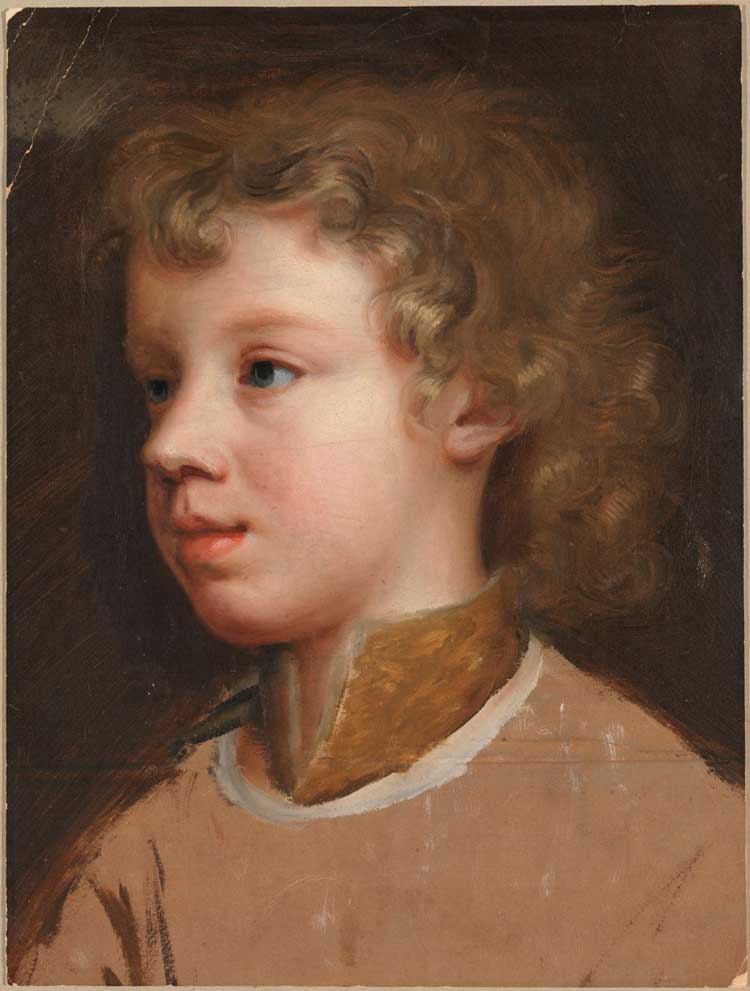
Mary Beale, Sketch of the Artist's Son, Bartholomew Beale, Facing Left, c1660. Photo: Tate.
And so to arrive at the exhibition. The opening rooms pack a punch, featuring those clearly intended to be the stars of the show: the aforementioned holy trinity of Gentileschi, Kauffman and Beale. By dint of each of these having been discussed in detail in their respective “solo retrospective” reviews, I shall keep things brief here. Of Beale, it is important to reiterate the professional union she had with her husband, Charles, who worked as her “studio manager”, keeping detailed records of her activity, purchases and sales, as well as preparing her canvases and mixing her paints. As a result, she was able to succeed as the breadwinner of the family, earning, from the 1650s onwards, £200 a year (the equivalent of what her contemporary Peter Lely was paid as portraitist to the King). Beale was prolific, with good connections and a good reputation. She also advertised in the London periodical A Collection for the Improvement of Husbandry and Trade. One of her works in this exhibition, Self-Portrait as Artemisia (c1675-80) (AKA Diana, goddess, among other things, of chastity and childbirth) was probably not intended as a self-portrait, and the same is said, despite its title, of Gentileschi’s Self-Portrait as the Allegory of Painting (La Pittura) (1638-39).
,-c1638-1639.jpg)
Artemisia Gentileschi, Self-Portrait as the Allegory of Painting (La Pittura), c1638-39. Royal Collection Trust / © His Majesty King Charles III 2024.
Each, nevertheless, uses the artist’s own likeness, and, furthermore, portrays her in a positive, flattering and respectable light to her audience. For female artists, this question of self-representation is complex, with the same dichotomous goal as discussed previously with relation to attaching one’s name to a work. Chapman writes: “[W]omen artists constantly had to safeguard the image they presented to the world. When they depicted themselves as working artists – holding a brush and palette – they tended to emphasise their charm and femininity, not their profession. Failing to achieve this delicate balance could result in the sort of scathing comments made by Fanny Burney following a visit to Catherine Read’s studio: ‘... she dresses in a style the most strange and queer that can be conceived and which is worst of all, is always very dirty’.”16, 17 Furthermore, female portraitists were at risk, when working with male sitters, of the time they spent together inevitably giving rise to malicious tittle-tattle. To protect themselves, many would have a family member act as chaperone. Early in her career, the 18th-century French portraitist Elisabeth-Louise Vigée Le Brun, for example, always painted with her mother in attendance, and were her sitter’s gaze to rove, she would announce that they must fix on a certain point as she was just about to paint their eyes. Another way in which female artists were disadvantaged was that they were not permitted to attend life classes to study the nude. Instead, they could learn human anatomy only by copying works by Old Masters and classical statues. There is some evidence that a few women contrived to circumvent this prohibition by hiring models privately, with Kauffman allegedly causing an uproar during her time in London by studying “an exposed male living model”.18
-Royal-Academy-of-Arts,-London-Photo-John-Hammond.jpg)
Angelica Kauffman, RA, Colouring, 1778-80 © Royal Academy of Arts, London. Photo: John Hammond.
Despite its narrowed geographic focus, the curators have pulled off a marvellous feat with their research for and loans to this exhibition. By broadening the parameters beyond the few celebrities more widely known, the roll call is extensive, and every visitor, I am sure, will come across names they didn’t know beforehand. That is why, despite the glory of the paintings showcasing the work of Gentileschi, Kauffman and Beale, it is the other sections of the exhibition that impress me more. To begin with, we travel back to the Tudor court, where we meet the “paintrix” Levina Teerlinc. She is recorded as a gentlewoman to Elizabeth I but was awarded an annuity of £40 by Henry VIII – a salary greater than Holbein’s. From 1559, she presented to Elizabeth as New Year’s gifts several works of art that are recorded but do not survive. She is even heralded as the “inventor” of the miniature.19 So why have we not heard of her? In the absence of any signed works or works that can be firmly linked to her with documents, the task of building her a 21st-century reputation is difficult to say the least.
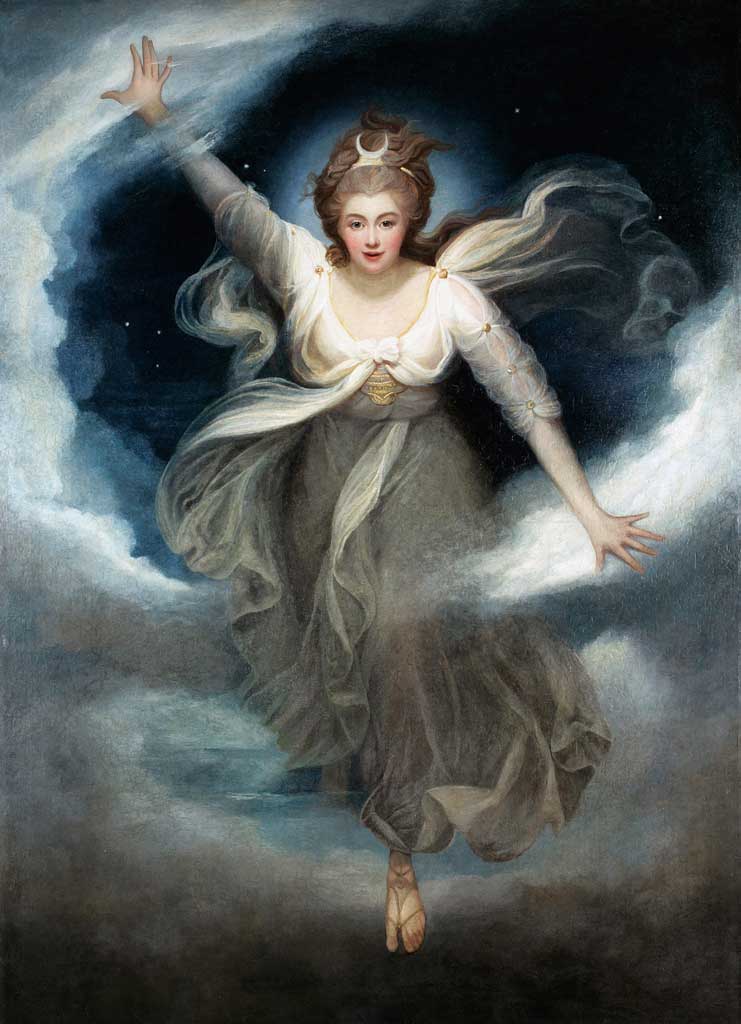
Maria Cosway, Georgiana as Cynthia from Spenser's 'Faerie Queene', 1781-82. Reproduced by permission of Chatsworth Settlement Trustees / Bridgeman Images.
Then we have Cosway. Following Kauffman’s departure from London in 1781, Cosway became the highest-profile female painter exhibiting at the Royal Academy, where, over two decades, she showed 42 pictures, including three self-portraits, history paintings and “in character” portraits. The work that brought her acclaim in 1782 is still a work of wonder today. A portrait of Georgiana, Duchess of Devonshire, as Cynthia (from Edmund Spenser’s poem, The Faerie Queene), it dominates all other paintings in that room, with Cynthia’s magical appearance from the stars and clouds above offering an apt analogy for the arrival of its painter on the scene. According to one critic at the time, this picture made Cosway “the first of female painters”.20
But casual disregard of female artists persisted. A case in point is Mary Moser, the second female founding member of the Royal Academy, along with Kauffman. During her lifetime, she was much admired from a young age for her paintings of typical English country garden flowers. She trained with her Swiss-born artist and goldsmith father, winning her first medal for flower drawing at 14. She went on to receive numerous royal commissions; nevertheless, few of her works survive. It certainly hasn’t helped that the relative value placed on the genre of floral painting is low, nor that many assume her success with the Academy to be attributable to her father being its first Keeper.21 Another name that has disappeared is that of Moser’s contemporary Mary Grace, whose Self-Portrait (1760s) on show here is her only surviving painting. During her lifetime, however, she exhibited annually from 1762-69 at the Society of Artists, to which she was elected an honorary member. As well as portraits, she showed narrative pictures and literary and classical subjects. At her death, she was able to leave a bequest of £1,300 to her daughter, ensuring her financial independence.22
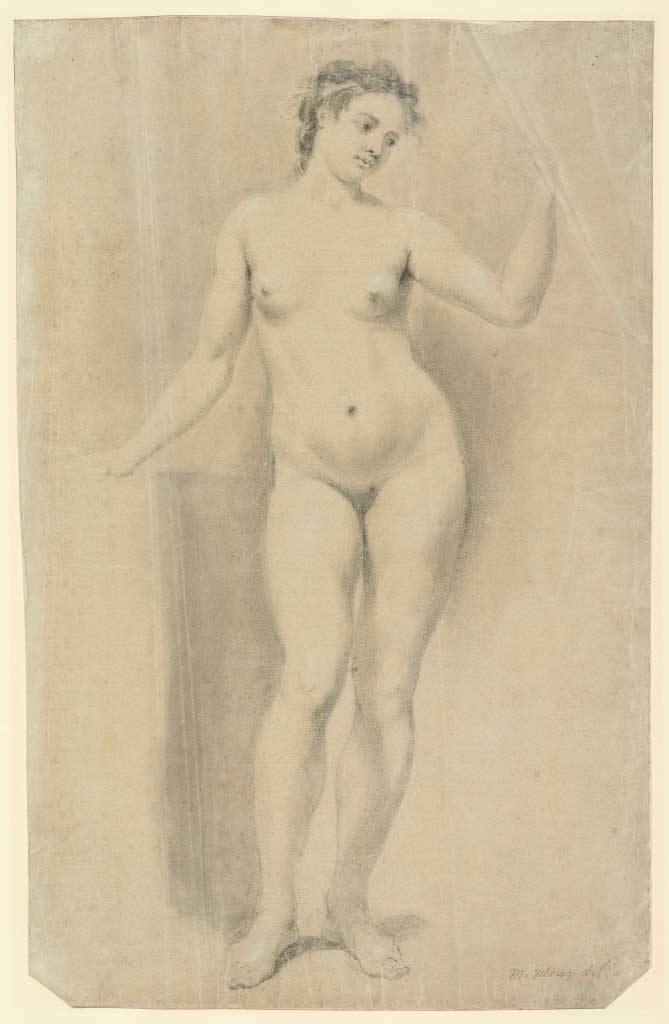
Mary Moser 1744-1819, Standing Female Nude. The Fitzwilliam Museum, Cambridge.
Moving into the 19th century, we meet the French animalière Rosa Bonheur, dubbed “the Female Landseer”, who became “the talk of all London” when she crossed the Channel to promote her tour-de-force painting The Horse Fair (1852-55).23 Critical praise, however, focused on what was termed her “masculine vigour”. Bonheur, who lived with quite the menagerie at home in the Fontainebleau forest, spent several weeks of her visit in the Scottish Highlands, where she fell in love with the sheep and cattle. In turn, these became the subject of many paintings and prints, with Sheep in the Highlands (1857), included here, providing a particularly delightful example. A fellow painter of animals, Lucy Kemp-Welch, had her picture Colt Hunting in the New Forest (1897) hung on the line at the 1897 Royal Academy exhibition, and it went on to become one of the first works by a female artist acquired by the then Tate Gallery.24
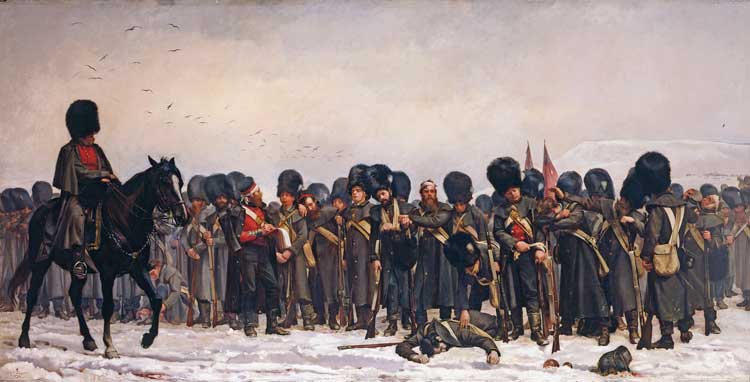
Elizabeth Butler, The Roll Call, 1874. Royal Collection Trust / © His Majesty King Charles III 2024.
Another artist to defy convention and pursue the traditionally male genre of history painting was Elizabeth Thompson (later Lady Butler), whose Calling the Roll After an Engagement, Crimea (more commonly known as The Roll Call) (1874) was so popular when shown at the Royal Academy that a policeman had to be stationed beside it to manage the crowds. Queen Victoria requested the picture be taken to the palace for a private viewing, and, even though it had been commissioned by someone else, she insisted on, and succeeded in, making it hers. Despite this resounding success, Butler was consistently denied membership of the Academy. For her part, the artist said that the praise she valued most highly was that given by veterans of the Crimean war, who noted the painting’s realism and accuracy.25
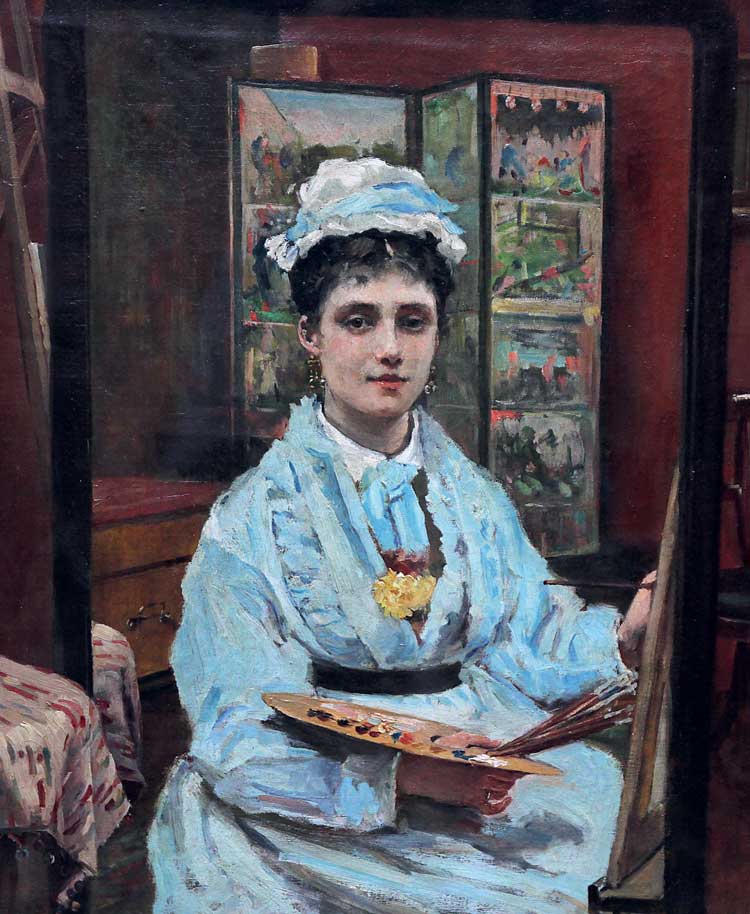
Louise Jopling, Through the Looking-Glass, 1875. Purchased with funds provided by the Nicholas Themans Trust and Tate Patrons 2024. Photo: Tate (Sonal Bakrania).
One of my favourite discoveries in the exhibition is the Victorian painter Jopling, whose Through the Looking-Glass, recently acquired by Tate, depicts her own image in a full-length mirror, sitting with her palette and brushes at her easel. In studying her reflection, her gaze directly and unabashedly meets that of the viewer – or should that be voyeur? It was made in 1875, four years after the publication of Lewis Carroll’s novel of the same title, to which Jopling was arguably making reference; the composition also seems to speak forward seven years to Édouard Manet’s A Bar at the Folies-Bergère, both in its challenging and somewhat intimidating eye contact, as well as the layer on complex meta-layer of who is looking at whom looking at what.
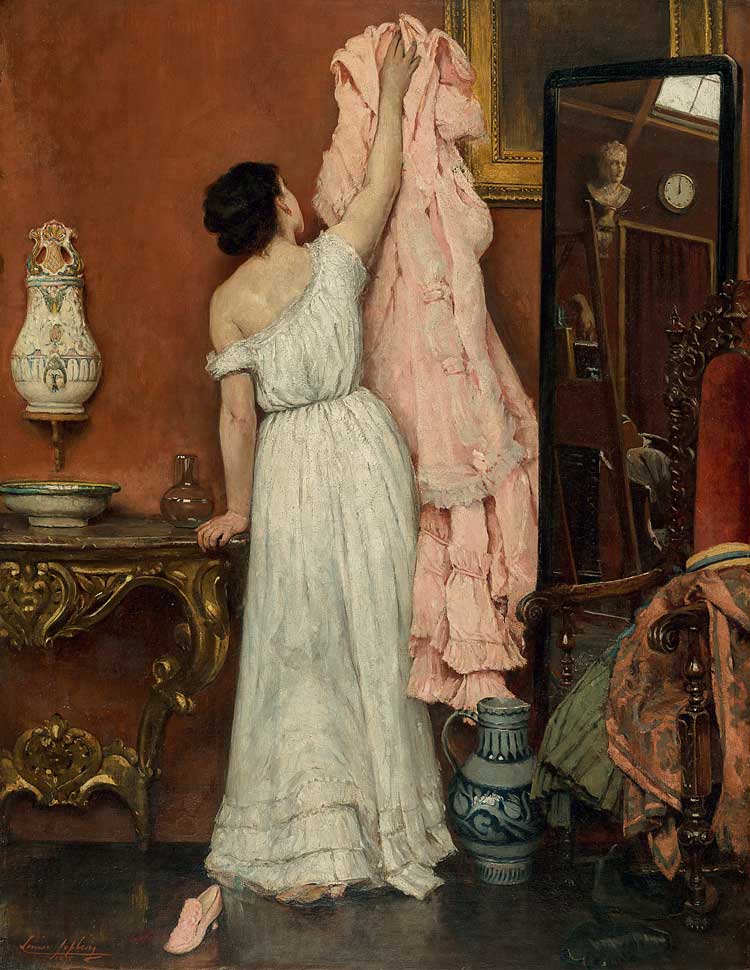
Louise Jopling, A Modern Cinderella, 1875. Private collection.
As a rather nice cherry on top, Tate is showing a second Jopling work from 1875, A Modern Cinderella, in which the female subject – presumably also the artist – reaches up while in her petticoats, which in so doing have slipped to bare her left shoulder, to hang an effervescent prawn-pink dress on a hook. This action takes place right next to the very black-framed standing mirror encountered in the first picture. Starting out as a hobby artist, who turned her pastime professional to support herself and her children after being abandoned by her first husband, Jopling became known for her fashionable salons and advancement of feminist causes, through, for example, the hosting of suffragist meetings at her studio. She also wrote for newspapers and magazines, published a handbook on art and an autobiography, Twenty Years of my Life (1925), and set up a school for female art students.26 Despite all this, a comment from Twenty Years is telling about the extra concerns borne by a woman artist at that time: “I found it at first a very difficult matter to price my work. The monetary side to an artist’s career seems sordid. Somehow, in asking money for one’s work, one has the feeling, more or less of being a robber and a thief.”27
Another quite breathtaking portrait on show is that of Elizabeth Montagu (1778) by Frances Reynolds, sister of Joshua. Denied training and the rite-of-male-passage Grand Tour, she taught herself to paint by making copies of his works, about which he scathingly remarked, that they “made others laugh and me cry”.28 Through a group of writers, artists and intellectuals known as the Bluestocking Circle, Frances came to know and befriend the philanthropist Montagu. When she asked to paint her portrait, Montagu agreed, on condition that she was not made to appear 15. The result is a ghostly grisaille that would not be ill-fitting if proffered as a portrait of Charles Dickens’s Miss Havisham!
While proceeding broadly chronologically, the curation of the exhibition is punctuated here and there by smaller galleries, serving as dressing rooms to the choruses, in between the larger ones reserved for the stars. These allow for excursuses on different mediums, including those considered typically feminine, such as embroidery, watercolour and pastels, as well as photography, which, as a radical new art form, permitted women to partake on a (almost) level playing field from the outset. Here, the pastels section is especially interesting, introduced by a quote from Joshua Reynolds, declaring use of the medium unworthy of “real” artists, and “just what ladies do when they paint for their own amusement”.29
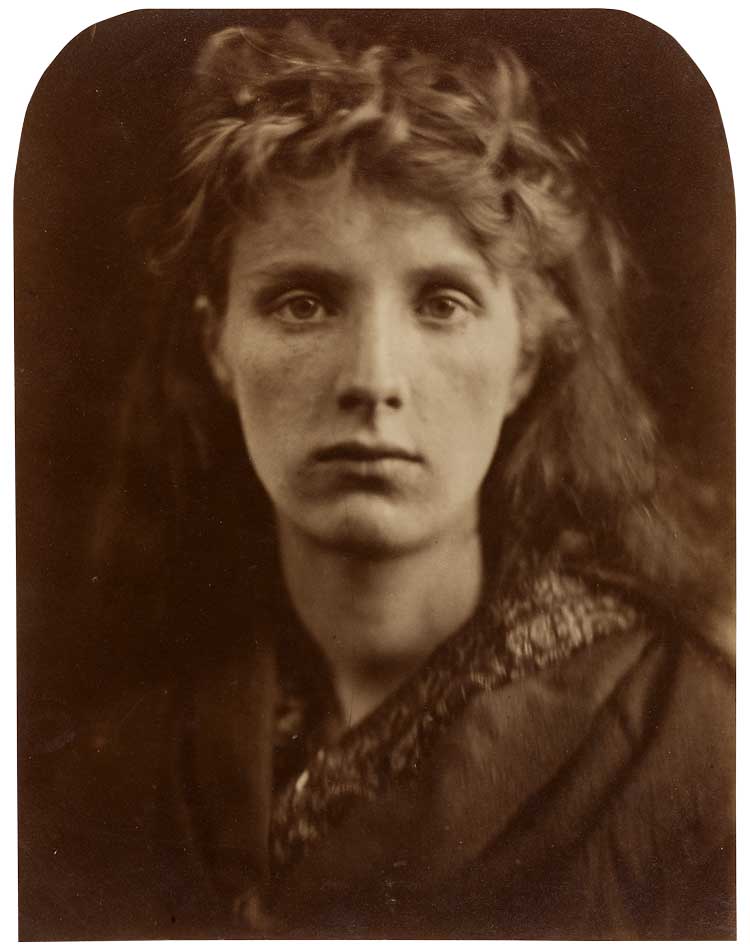
Julia Margaret Cameron, Mountain Nymph, Sweet Liberty, 1865. Wilson Centre of Photography.
In the photography section, there are, of course, the usual suspects, including Julia Margaret Cameron – to whom the Pall Mall Gazette of 1895 advised other female photographers to “turn, for an example and guide”30 – and Lady Clementina Hawarden. In addition, however, it is worth mentioning Emma Barton, whose The Soul of the Rose (c1905) is every bit as enchanting as a pre-Raphaelite painting, reminding me especially of one of my all-time favourites, JW Waterhouse’s Psyche Entering Cupid’s Garden, painted just two years earlier; Zaïda Ben-Yusuf, whose The Odour of Pomegranates (1899) sees her subject dissolving into the patterned backdrop, made from the same fabric as her dress, in a manner prescient of the work of Francesca Woodman, almost eight decades later; and Caroline Emily Nevill, by whom there is a photograph of St Mary’s Abbey, West Malling, Kent (c1854-56), which came as a pleasant surprise, it being the village next to that where I grew up.
The catalogue tells us that Elizabeth Eastlake, wife of the first president of the Photographic Society of London, wrote in 1857 that photography was “a kind of republic”, uniting those of “the most diverse lives, habits, and stations”, including “not least, the fair woman whom nothing but her own choice obliges to be more than the fine lady”.31 But, of course, things were not equal, and while women were admitted to the society, few attended its meetings. Until the end of the 19th century, the two watercolour societies allowed women entry only under the category of “Lady Members”. Two years before Eastlake noted the above saw the creation, as an initial sign of resistance, of the Society of Female Artists, which later became the Society of Lady Artists, and then the Society of Women Artists, which it remains to this day.32 The Royal Academy, for its part, was subject to repeated petitioning for equality – and some of these lists of signatures are included in the exhibition – from 1859 on. Initially, the request was for female students to be admitted per se, which only came about the following year when Laura Herford was “accidentally” accepted, having submitted her application using only her initials; thereafter, it was for female students to be allowed to join the life class, which was not approved by the council until 1883, when it was still rejected by the general assembly, who finally conceded in 1893 – and then only if the model wore a loincloth. By contrast, the Slade School of Fine Art admitted women on equal terms to men from its beginnings in 1871, boasting, perhaps as a result, more female than male students. It is represented here by Ida Knox, whose Male Figure Seated (1918) won first prize for figure painting, and Elinor Proby Adams, whose Female Seated Figure (1906) had won second prize a decade earlier. It was not until 1922, with the election of a nearly octogenarian Annie Swynnerton – who saw her career as a struggle against the belief that “women could not paint”33 – as an Associate Royal Academician, that a woman followed in the footsteps of Kauffman and Moser; Laura Knight followed Swynnerton in 1927, going on to become the first full Academician in 1936. Swynnerton’s near-life-size female nude, Mater Triumphalis (1892), is as impressive today as it doubtless was then. Nearby, Evelyn de Morgan’s The Martyr (Nazuraea) (1880) is even more monumental in scale, and, while clothed (in the most figure-hugging and vibrant red dress), is certainly every bit as risqué, with its clear reference to Christ on the cross.
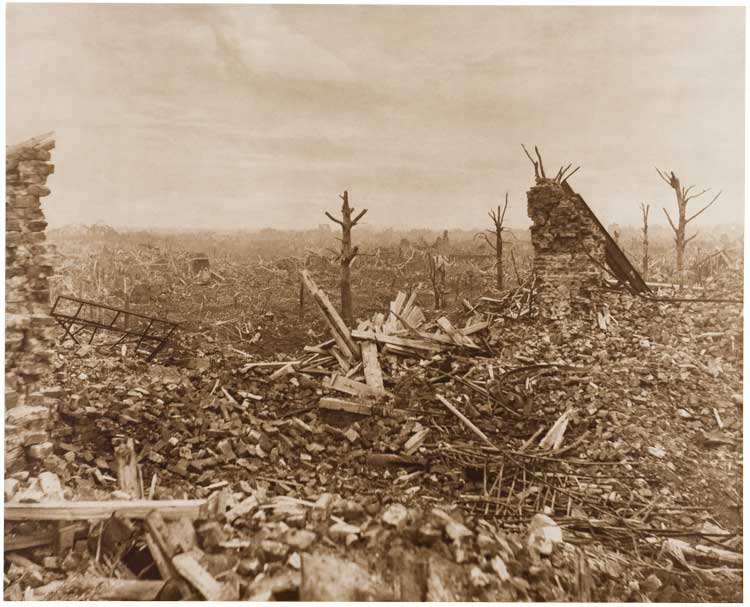
Olive Edis, War, 1919. Wilson Centre for Photography.
The role of family is another subject entered into by the curators, and both Knight and De Morgan were married to artists (the latter, it is said, having made his acquaintance while she was dressed as a tube of paint at a party). Laura Alma-Tadema was pupil and wife of Lawrence Alma-Tadema, and they both signed their work with just the initial L, Lawrence adding an opus number, where Laura had none. While being recognisably of a kind with his, her pictures – for example, A Looking Out o’Window (Sunshine) (pre 1900), with its chintzily clad, blond cherub of a little girl sitting on the sill – are far more cloying, in a way, dare I say it, in which only something produced by a woman could be. Further paintings with excessively domestic subjects are those by Solomon, sister to Simeon and Abraham, and the first female professional Jewish artist in Britain. Feminist writer Germaine Greer made the claim in her 1979 book, The Obstacle Race: Fortunes of Women Painters and Their Work, that: “The single most striking fact about the women who made names for themselves as painters before the 19th century is that almost all of them were related to better-known male painters.” This may well have been the case until far more recently than we care to admit.34
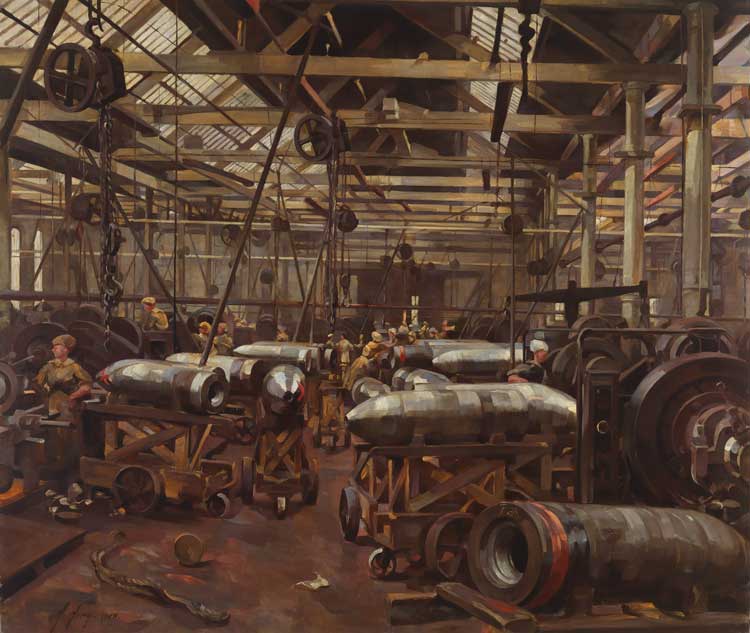
Anna Airy, Shop for Machining 15-inch Shells: Singer Manufacturing Company, Clydebank, Glasgow, 1918. © Imperial War Museum.
The final rooms of the exhibition hastily bring us to its chosen cut-off point of 1920, with the early post-Victorian period being structured primarily around artist groups (the Camden Town Group, which notoriously excluded women; the New English Art Club, of which Gwen John and Clare Atwood were members; and the Fitzroy Street Group, which featured Ethel Sands and her partner, Nan Hudson). There are also plentiful examples of grand firsts, such as Edmonia Lewis – the first sculptor of Black and Native American descent to achieve international fame; Olive Edis – Britain’s first female war photographer; and Anna Airy – Britain’s one of the first official female war artists commissioned by the newly founded Imperial War Museum. Atwood further ticks the box for being lesbian – a personal detail flagged for a number of the modernists who close the show – and The Terrace Outside the Priest’s House (1919) depicts her at ease with the theatre director Edith Craig and writer Christabel Marshall, with whom she openly lived in a ménage à trois. Interestingly, the figure farthest forward in the composition is wearing a gold band on her ring finger. Unfortunately, however, these various firsts and minority groups have, for me, a none-too-sweet flavour of tokenism as the roll call proceeds.
.jpg)
Gwen John, Self-Portrait, 1902. Photo: Tate (Mark Heathcote and Samuel Cole).
A rather more arbitrary grouping to end with (one selected by me, if not intentionally by the curators) is the collection of Ethels: Sands, Wright and Walker. The first’s Tea with Sickert (c1911-12) is a gloriously chaotic and patterned composition, redolent of the intimist style of Édouard Vuillard. Wright, on the other hand, became known for her portraits of leading feminists and suffragists, of which The Music Room, Portrait of Una Dugdale (c1912) is exemplary. Dugdale had caused a public scandal earlier that year by refusing to promise to obey her husband during their marriage vows, and the polemical pamphlet she published in 1913, arguing her case, is exhibited alongside the portrait (interesting, if slightly tenuous in my opinion). The final Ethel, the Scottish painter Ethel Walker, is represented by a number of works, which show how her style altered over time. While her earlier The Garden (c1899) is impressionist in approach and subject, with the beautifully frothy skirt of the woman’s white dress reflecting all the pastel colours of the rainbow (and the roses by which she is surrounded), her later work, The Excursion of Nausicaa (1920), is far more decorative and Bloomsbury-esque in tone, described in the catalogue as “a utopian vision of nude women adopting gentle, nurturing poses, variously feeding, serving and touching one another”.35 It was purchased by Tate in 1924, and Walker was one of only five female (and 35 male) artists whom its director, John Rothenstein, considered worthy of an essay in his study, Modern English Painters.36 Even then (and rightly so) wanting more of her dues, Walker wrote Rothenstein a letter putting forth her case for him to acquire further examples of her work. “Every purchase of my work,” she wrote, “strengthens and enriches the sum of good pictures at the Tate Gallery.”37 Perhaps unsurprisingly, Walker went on to achieve many professional milestones, exhibiting around the world and representing Britain at the Venice Biennale no less than four times. After her death, the Times referred to her as “the most important woman artist of her time”. In her own words, however, Walker pronounced a sentiment I hold on to every bit as firmly now as I did before visiting this momentous exhibition – indeed I am undecided as to whether it served to call into question or to strengthen this belief – namely: “There is no such thing as a woman artist. There are only two kinds of artist – bad and good.”
References
1. Women Artists: 1550-1950 by Ann Sutherland Harris and Linda Nochlin, exhibition catalogue, Los Angeles County Museum of Art, 1976, page 54.
2. Eighteenth-Century Women Artists: Their Trials, Tribulations and Triumphs by Caroline Chapman, Unicorn Publishing, 2017, pages 198-201.
3. Stuart Macdonald in The History and Philosophy of Art Education, New York, 1970, cited in Women Artists: 1550-1950, op cit, page 55.
4. Why Have There Been No Great Women Artists? by Linda Nochlin, ARTnews, January 1971.
5. Old Mistresses. Women, Art and Ideology by Rozsika Parker and Griselda Pollock, 1981, IB Tauris & Co Ltd, London/New York, 2013, page 49.
6. Ibid, page 3.
7. Chapman, 2017, op cit, pages 15-17.
8. Ibid, page 41.
9. Cited in Now You See Us. Women Artists in Britain 1520-1920, exhibition catalogue, Tate Britain, London, 2024, page 11.
10. Cited in Chapman, 2017, op cit, page 21.
11. Now You See Us, 2024, op cit, page 11.
12. Ibid, page 12.
13. Ibid, page 49.
14. Sutherland Harris and Nochlin, 1976, op cit, page 30.
15. Now You See Us, 2024, op cit, page 50.
16. Chapman, 2017, page 70.
17. The spelling, Catherine, is the one most commonly used, but Tate has chosen to go with Katherine.
18. Ibid, page 45.
19. Now You See Us, 2024, op cit, pages 21-22.
20. Ibid, pages 67-68.
21. The Obstacle Race by Germaine Greer, 1979, Picador, 1981, page 248.
22. Now You See Us, 2024, op cit, page 50.
23. Ibid, page 116.
24. Now You See Us in Tate etc, spring 2024, issue 61, page 77.
25. Now You See Us, 2024, op cit, page 122.
26. Ibid, page 126.
27. From Twenty Years of my Life by Louise Jopling, 1925, cited in Canvassing. Recollections by Six Victorian Women Artists, edited by Pamela Gerrish Nunn, Camden Press, 1986, page 144.
28. Now You See Us, 2024, op cit, page 66.
29. Ibid, page 85.
30. Ibid, page 159.
31. Ibid, page 155.
32. Ibid, page 147.
33. Ibid, page 134.
34. Greer, 1979, op cit, page 12.
35. Now You See Us, 2024, op cit, page 200.
36. A World of Our Own. Women as Artists Since the Renaissance by Frances Borzello, Watson-Guptill Publications, New York, 2000, page 175.
37. Now You See Us, 2024, op cit, page 200.